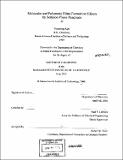| dc.contributor.advisor | Paul E. Laibinis. | en_US |
| dc.contributor.author | Kim, Namyoung, 1973- | en_US |
| dc.contributor.other | Massachusetts Institute of Technology. Dept. of Chemistry. | en_US |
| dc.date.accessioned | 2005-09-27T19:50:09Z | |
| dc.date.available | 2005-09-27T19:50:09Z | |
| dc.date.copyright | 2000 | en_US |
| dc.date.issued | 2000 | en_US |
| dc.identifier.uri | http://hdl.handle.net/1721.1/9002 | |
| dc.description | Thesis (Ph.D.)--Massachusetts Institute of Technology, Dept. of Chemistry, 2000. | en_US |
| dc.description | Includes bibliographical references. | en_US |
| dc.description.abstract | This thesis details studies of the chemical reactivity of silicon surfaces and the development of new reactions for manipulating its surface properties by the formation of covalently attached molecular and polymeric films. Silicon is the central material in modern electronic devices, and the ability to tailor its surface, particularly in a hydrogen-terminated form, at a molecular level has been desired. In this research, porous and crystalline silicon were examined as substrates, where the latter material can offer notable interesting luminescent properties. Chapters 2 and 3 discuss the formation of molecular films on hydrogen-terminated silicon surfaces by reactions using alcohols and Grignard and organolithium reagents. In the first reaction, alcohols formed alkoxy films to silicon surfaces via Si-0 bonds after reaction for 1-2 h at 40-90 °C. Alcohols were suggested to react with surface Si-Si bonds to cleave these bonds and produce Si-OR and Si-H species. In the second reaction, molecular films were obtained on silicon by exposing silicon substrates to Grignard and organolithium reagents at room temperature for 1-6 h and a quench with an anhydrous acid. A mechanism is proposed whereby the reagent alkyl anions cleaved surface Si-Si bonds and produced Si-R attachments anchored by Si-C bonds and an equivalent of silyl anions that were later quenched using an acid or an acyl halide. Both reactions caused little surface oxidation, and modified porous silicon samples retained their luminescent properties. Molecular films formed on crystalline silicon supports by these reactions exhibited a surfoce coverage of 50-90 % and moderate packing density. Chapters 4 and 5 describe the use of these thin molecular films for forming polymer films on crystalline silicon supports. In Chapter 4, a pyrrole-terminated molecular film was formed on a hydrogen-terminated silicon substrate using a pyrrole-terminated organolithium reagent. The electrochemical polymerization of pyrrole on the support produced polypyrrole films that were covalently attached to the substrate. The resulting polymer films demonstrated improved physical properties such as smooth and uniform surface morphology and strong adhesion to the substrate over those formed to native hydrogen-terminated silicon surfaces. Similarly, the junctions containing a modified silicon substrate exhibited enhanced electrical characteristics due to efficient charge transfer at the interface over those of an unmodified substrate. In Chapter 5, a norbomene-terminated molecular film was prepared on silicon bearing thin native oxide and used for a surface-initiated ring-opening metathesis polymerization (ROMP) process. In this strategy, a Ru-based ROMP catalyst was immobilized onto the modified silicon surface by reaction with a norbornenyl monolayer. Upon exposure to solutions of various norbornene-based monomers, the attached catalyst produced a series of grafted polymer films with control over thickness and chemical composition of the films. By combining this method with microcontact printing ([mu]CP), the procedure was used to generate patterned polymer films on silicon by simple solution-phase reactions. | en_US |
| dc.description.statementofresponsibility | by Namyoung Kim. | en_US |
| dc.format.extent | 200 leaves | en_US |
| dc.format.extent | 12917732 bytes | |
| dc.format.extent | 12917489 bytes | |
| dc.format.mimetype | application/pdf | |
| dc.format.mimetype | application/pdf | |
| dc.language.iso | eng | en_US |
| dc.publisher | Massachusetts Institute of Technology | en_US |
| dc.rights | M.I.T. theses are protected by copyright. They may be viewed from this source for any purpose, but reproduction or distribution in any format is prohibited without written permission. See provided URL for inquiries about permission. | en_US |
| dc.rights.uri | http://dspace.mit.edu/handle/1721.1/7582 | |
| dc.subject | Chemistry. | en_US |
| dc.title | Molecular and polymeric films formed on silicon by solution-phase reactions | en_US |
| dc.type | Thesis | en_US |
| dc.description.degree | Ph.D. | en_US |
| dc.contributor.department | Massachusetts Institute of Technology. Department of Chemistry | |
| dc.identifier.oclc | 47360099 | en_US |
